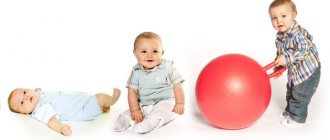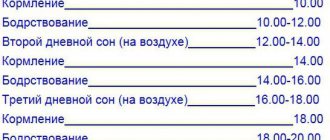Features of infant physiology
A 1 month old newborn child no longer experiences the discomfort of muscle hypertonicity, which clenched the baby’s fists and forced him to press his arms to his body. They move freely and unconsciously, since the baby has not yet learned to control them.
The umbilical wound has completely healed, turning into a real belly button. And a baby’s sleep at 1 month is so long that it allows the mother to finally feel a little more freedom in doing household chores. During the day, the baby will sleep at least 6 times, the total rest time will be 6-7 hours. The baby will sleep for another 8-10 hours at night, perhaps without even bothering you for night feeding. Even the most active one-month-old babies are awake only 6 hours a day, but real sleepyheads rest for all 20 hours.
A baby's stool at 1 month is extremely individual. Some babies can please their mother with a dirty diaper even after every feeding, up to 10 times a day. On average, the number of poops is 4-6. There are also very restrained babies who empty their bowels every other day (this is especially true for artificial babies). But if the baby feels well, he is not bothered by his tummy, which is absolutely soft, which means that such rare bowel movements are normal for him.
The weight of a child at 1 month is also individual, as are the indicators of height and head circumference.
| Weight, kg | Height, cm | Head circumference, cm | |
| Girls | 3,2-5,5 | 49,8-57,6 | 34,2-38,9 |
| Boys | 3,4-5,8 | 50,8-58,6 | 34,9-39,6 |
The first weigh-in in the pediatrician's office at 1 month of the child's life will show the dynamics of weight gain and growth. His indicators are growing, which means that the physical development of a child of 1 month of life is proceeding normally.
Basic Skills
What should a 1 month old baby be able to do? Eat and sleep? Not at all! A baby's skills at 1 month are much more diverse! The baby can:
- Lying on your tummy, raise your head for a very short time, just 15-30 seconds. He will hold his head more confidently at 2 months, but now the mother should definitely support her head when the baby is in her arms.
- Actively move your arms and legs, lift your butt and arch your back - these movements are still involuntary, but they are an excellent exercise for the baby’s muscles.
- Make sounds - babies with whom their mothers talk a lot begin to roar as early as a month. It is at this early age that you will be able to hear the first “aha” from your baby in response to your quiet conversation or song.
- Fixing his gaze on a stationary object - the baby really likes to look at his mother’s face. And in one of these moments you will be able to notice his first conscious smile.
- Distinguish sounds - in the first month of a child’s life, his development is sufficient to recognize the voices of his own and others. Moreover, the baby may be scared of the latter.
- Distinguish between lines and checkered patterns, as well as colors - white and black, red and yellow.
- Get to know mom! This is probably the most important aspect that a 1 month old baby can do. Moreover, the baby recognizes its mother not by sight, but by smell, voice, touch. His tactile sensations are incredibly developed, so during this period the mother should not handle the baby with sweaty or cold hands or use perfume that will interrupt the natural aroma of the body.
Child development: what a child should be able to do by age
- 1 month
In the first week of life, a newborn loses up to 8% of his birth weight, then his weight begins to increase. Around the 7th day, the umbilical cord remnant falls off. Until the 3rd week, the baby perceives only loud sounds, since the ears are covered with fetal fluid. By the end of the month, his skin gradually brightens and acquires a natural color. The baby's muscles are in what pediatricians call physiological tone, so the arms and legs are always bent, and the palms are clenched into fists. The child can see objects at a distance of up to 30 cm and turns his head towards the light. During this period, colic and regurgitation most often occur. The baby needs to be placed on his tummy, while he raises his head and holds it for a few seconds. In the first month of life, weekly visits to the baby by a pediatrician are mandatory. To communicate to parents about their needs, the baby cries and calms down when he is held. At a time he eats 80-120 ml of breast milk or its substitute - formula. Feeding frequency is approximately every 2 hours. The average weight gain is 1 kg, height gain is 2 cm. ...read more...
- 2 month
The baby is already making distinct sounds, purring and cooing. The tone of his voice changes. When he sees his parents, he smiles, begins to distinguish voices, and listens to conversations. During this period, he smiles for the first time, albeit unconsciously. In order for the baby to hold his head confidently, you need to lay him on his tummy more often. This same exercise will strengthen your abdominal muscles and help get rid of colic. Holds a rattle in his hand, shakes it, carefully watches the toys. He turns on his side and sleeps on it. Lying on his back, straightens his arms and legs. Pulls hands into mouth, salivating profusely. When crying, tears appear. It's time to develop visual skills by attaching a mobile to the crib. Daily walks in the fresh air are very important for a child’s health, and attention should also be paid to developing a sleep and wakefulness routine. During the second month of life, the child gains about 800 g and stretches a couple of centimeters. ...read more...
- 3 month
The baby is already able to sense the surrounding environment and sees more and more objects. He likes to be carried in a column so he can see more of his surroundings. Studying palms and fingers. Turns his head in different directions in search of the source of sound, clearly distinguishes the faces of those around him. Begins to distinguish odors. From this month, parents need to monitor their baby more closely, because he begins to roll over from his back to his tummy. Another achievement is that he already confidently holds his head while in an upright position on his arms or lying on his stomach. Now the baby will love the bright developmental mat that rocks the center. If you put a multi-colored toy in front of him, he will try to reach out and grab it on his own. Puts rattles in his mouth. The average weight gain is 800 g, height gain is 2 cm. ...read more...
- 4 month
The period of colic gradually passes, now the baby can sleep a little longer and wake up for feedings less often. Lying on his tummy, he tries to get up, leaning on his arms. He recognizes his mother among other people, smiles at her, and talks to her. Listens to music. Of particular interest is his reflection in the mirror. Can focus longer on objects or some process. Rolls over from back to side and onto stomach. Tries to roll over onto his back. Reaches for toys, takes a toy with both hands. Pushes off with legs and arms from the support. Lying on his back, he raises his head and presses his chin to his chest. If you pull him by the arms, he tries to sit down. He takes a toy and shakes it with one hand, reacting joyfully to the music that he likes. Actively tries to participate in the conversation, babbles individual syllables with varying strength. Weight gain – 700-800 g, height – 1-2 cm. ...read more...
- 5 month
Features of care for proper development
Proper care of a 1 month old baby will ensure its proper development. What do you need to do? Just be nearby all the time that you can afford and respond to the baby’s requests “at the first squeak.” Take him in your arms more often, talk, play. And do not pay attention to the advice of grandmothers and neighbors who believe that such behavior will make a child selfish. Just the opposite. Children deprived of their mother's care often begin to scream for no reason simply to attract her attention. A baby who knows that his mother will come when called will not cry again.
Games
The following will help develop your child’s attention and tactile skills:
- large contrasting figures and bright toys in colors that the baby can already distinguish;
- black and white pictures with large spiral patterns or in the form of a chessboard;
- air balloons;
- mobile - or a children's carousel with large figures and music. Let the number of these figures be small, 3-4 pieces are enough;
- a developmental mat or arc - you can simply play with the latter in the crib.
Swimming
For a 1-month-old newborn, development may well include infant swimming in the pool with his mother and instructor. You can also swim in your home bathtub. Buy an inflatable donut ring for your baby’s neck and fill a bath full of water at a comfortable temperature. Dip the baby into the water and help him get comfortable by holding him under his arms. Already for the 3rd time, the child will be happy to splash around on his own, moving in the water. And you can just be nearby.
Starting from 1 month of life, the development of the baby will be very active. Capture every moment with your camera. In just a year, you will happily look at the pictures, wondering how much your child could do!
Child development calendar by month
From birth to 1 month, the baby is very weak, so he mostly sleeps. He cannot hold his head, his arms and legs are tucked in because the muscles are not yet developed. The child's weight is 2.5 - 4.5 kg with a height of 45 - 54 cm. The baby does not distinguish colors and sounds, since the organs responsible for vision and hearing develop over 90 days.
From 1 to 2 months, external changes appear on the face. The baby's movements become active. He begins to raise his head and straighten his fingers. The baby already recognizes his own faces and curiously examines everything that surrounds him. Distinguishes sounds, so you need to be careful not to scare him.
From 2 to 3 months the child is in an active stage of development. He becomes increasingly interested in the objects around him and displays the ability to grasp and squeeze them. The baby tends to raise his head on his own, lying on his tummy, and sit up. Height reaches 53 – 62 cm, and weight from 4 to 7 kg. In the first trimester of the year, the development of the baby’s body is relatively systematic. Therefore, sleep and alertness patterns begin to normalize.
From 3 to 4 months the baby adapts to the environment. The development of a child at 3 months is determined by his ability to actively express his emotions. The baby's facial expressions become more active.
He already lives according to a stable regimen of feeding, vigor and rest. Mothers can calmly plan their day, because it is by this time that the child begins a period of relative calm.
From 4 to 5 months, the baby holds his head independently. He can stand on his legs, however, with the help of support under his arms. Carefully watches the movements around him. During this period, teeth are cutting through, the baby begins to cry, pull into his mouth everything that comes to hand, and this is accompanied by strong salivation. The child communicates using sounds and gestures and expresses his emotions with a smile and laughter.
From 5 to 6 months, the baby begins to sit in a playpen or chair, but with the help of support. The baby also rolls over on its own from its back to its tummy. He constantly attracts attention with active movements, crying and loud sounds. During this period, the grasping reflex is developed, the child shifts an object from hand to hand, throws it and picks it up. The muscles are almost fully developed, so the baby is not only able to rise, but also crawl.
At 5.5 months, the baby’s development takes an active form. He also sleeps three times a day for about 2 hours, and can fix his gaze on an object that was shown to him.
From 6 to 7 months, the child grows to 60-70 cm, and his body weight is from 5.5 to 9 kg. The teeth are being cut actively, the baby begins to crawl intensively. He can play without your participation, the main thing is to provide the child with an area where he will be safe. After the first half of the year of life, his activity and interest in the environment increases. At this time, you should especially pay attention to the psychological development of the child.
From 7 to 8 months, the child happily walks outside, actively crawls and plays independently. He recognizes his name, recognizes his relatives, and remembers objects by name.
From 8 to 9 months, the baby develops finger motor skills or (in other words) tweezer grip. He can take objects and toys not only with his whole palm, but also with two or three fingers. The child has a more varied diet, but growth and weight slow down. But he begins to say some words.
From 9 to 10 months, the baby slowly gets up and even takes his first steps, although leaning on something. It is the third trimester of the year that shows your child’s adaptation to the world around him. Some children learn new things on their own, while others cannot be left alone and require attention. The baby expresses his demands, at this time the parents must clearly define for him the limits of prohibition and permissibility.
From 10 to 11 months, the child crawls, overcoming various obstacles. For the first time he tries to go down the steps. The walking process will constantly evolve, so it is advisable to secure the space around it.
From 11 to 12 months, the baby's diet includes components that replenish his energy. Dairy products, porridge, vegetables, meat, fruits - all these are products that help the child’s body develop and receive enough vitamins. In connection with this complementary feeding, you need to start brushing your teeth.
At 1 year old, the child practically understands what is being said to him, remembers where objects are located, and already knows what he can and cannot do. At this age, he fully demonstrates his character.
This calendar helps parents track their child’s development month by month up to a year. Since it contains standards that help develop new skills appropriate to the baby’s age. With the help of a structured schedule, young mothers will be able to adhere to parenting standards, see the child’s development month by month, and take into account the child’s developmental characteristics.
While in the womb, the baby is already a developing human personality. Therefore, the mother’s attitude towards the unborn child, her thoughts about his appearance, communication, love for him - all this affects the development of the baby in the future.
Many psychologists pay great attention to the problems of early childhood. Indeed, in the first months and years of life, it is the parents who influence the physical, moral and psychological development of the child.










